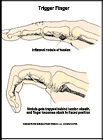
Trigger Finger
What is trigger finger?
Trigger finger is a condition in which it is difficult to straighten a finger (or fingers) once bent. The medical term for trigger finger is stenosing tenosynovitis.
How does it occur?
Trigger finger results from inflammation or swelling of the fibrous sheath that encloses the tendons. A tendon is a band of strong fibrous tissue that connects a muscle to a bone.
The straightening mechanism hesitates for a few moments before the tendon suddenly overcomes the resistance. The finger then straightens with a sudden jerk or triggering motion.
What are the symptoms of trigger finger?
Symptoms include:
- a snapping sensation (triggering) in the affected finger or fingers
- inability to extend the finger smoothly or at all (it may lock in place while bent)
- tenderness to the touch over the tendon, usually at the base of the finger or palm
- soreness in the affected finger or fingers.
How is trigger finger diagnosed?
Your health care provider will review your symptoms and examine you.
How is trigger finger treated?
Sometimes it is helped by ice and anti-inflammatory medication, such as ibuprofen. If this does not work, your health care provider may give you an injection of a local anesthetic to keep you from feeling pain in the area and a corticosteroid (cortisonelike medicine) to reduce the inflammation of the tendon sheath.
If necessary, surgery will be done to remove the part of the tendon sheath that is causing the tendon to get stuck.
When can I return to my sport or activity?
You may return to your sport or activity when your finger no longer catches or locks.
How long do the effects of trigger finger last?
The severity of trigger finger varies from person to person. Although response to treatment varies, results are usually good. It is best to discuss progress with your health care provider on a regular basis. Surgery for this condition is usually very successful.
How can I take care of myself?
It is important to follow your health care provider's instructions. In addition, rest and limit the activity of the affected finger or fingers and of the hand and wrist.
What can I do to help prevent trigger finger?
Since the cause of trigger finger is unknown, there is no reliable way to prevent this condition from developing.

